
Introduction
The SMILO series of radio control devices is
based on a system for sending a coded signal
from a transmitter to a receiver. If this signal is
recognised as valid, it activates the output
relays. The SMILO system uses the “rolling
code” transmission technique which makes the
radio control device extremely safe. This
method ensures that the recognition code is
different for each transmitter and that it
changes every time it is used.
Introduzione
Il radiocomando SMILO è un sistema che,
mediante un trasmettitore, invia al ricevitore un
“segnale” che, se riconosciuto come valido,
provoca l’attivazione dei relè d’uscita. SMILO
utilizza una tecnica di trasmissione denominata
a codice variabile (Rolling Code) che rende il
Vostro radiocomando estremamente sicuro.
Infatti mediante questa tecnica il codice di
riconoscimento è diverso per ogni trasmettitore
ed inoltre cambia ogni volta che viene utilizzato.
GB
I
remote controls
Introducción
El radiomando serie “SMILO” es un sistema
basado sobre el envío de una señal codificada
desde el transmisor al receptor. Si dicha señal
es reconocida como válida, provoca la
activación de los relés de salida. El sistema
SMILO utiliza una técnica de transmisión
denominada de código variable (Rolling Code),
que garantiza una extrema seguridad de los
radiomandos. Por medio de esta técnica, el
código de reconocimiento es distinto para cada
transmisor y cambia cada vez que es utilizado.
Introduction
La radiocommande série “SMILO” est un
système basé sur l’envoi d’un signal codé de
l’émetteur au récepteur. Si ce signal est
reconnu comme valable, il provoque l’activation
des relais en sortie. Le système SMILO utilise
une technique de transmission dite à code
variable (Rolling Code) qui rend la
radiocommande extrêmement sûre. Grâce à
cette technique, le code d’identification est
différent pour chaque émetteur et change à
chaque fois qu’il est utilisé.
Einleitung
Bei der Fernbedienung der Serie “SMILO”
handelt es sich um ein System, das auf der
Übertragung eines codierten Signals vom
Sender zum Empfänger beruht. Wird dieses
Signal als gültig anerkannt, so verursacht es die
Aktivierung der Ausgangsrelais. SMILO
verwendet eine Übertragungstechnik mit
variablem Code (Rolling Code), das die
Fernbedienung sehr sicher macht. Bei dieser
Technik ist der Erkennungscode für jeden
Sender anders und er ändert sich bei jeder
Verwendung.
Wstęp
Pilot radiowy z serii "SMILO"jest systemem
opartym na przesyłaniu sygnału kodowanego
z nadajnika do odbiornika. Gdy sygnał jest
pozytywnie rozpoznany przez odbiornik, to
powoduje uaktywnienie przekaźników
wyjścia. System "SMILO" stosuje technikę
przekazywania ze zmiennym kodem (Rolling
Code), który powoduje, że pilot jest
nadzwyczaj bezpieczny i pewny. Poprzez
zastosowanie tej techniki kod rozpoznawania
jest inny dla każdego nadajnika i zmienia się
przy każdorazowym użytkowaniu.
F E
D PL
smilo
Page is loading ...

3
Installation
Power input selection Insert or remove a jumper from its seat (Fig.3) to select power input:
Jumper not inserted 24 V ac/dc Voltage limits: 18 ÷ 24 V
Jumper inserted 12 V ac/dc Voltage limits: 10 ÷ 18 V
Electrical connections The receiver is connected by different coloured wires (Fig.4):
Red / Black POWER INPUT
Red= Positive, Black= Negative. Position is not important if alternating current is selected
White / White RELAY 1 OUTPUT Free contact of a normally open relay
Purple / Purple RELAY 2 OUTPUT Free contact of a normally open relay
Terminals 1, 2 AERIAL Aerial signal input (terminal 1 braid, terminal 2 core)
Contact in receiver output
The outputs are commanded by a relay with a normally open “NO” contact. If a normally closed “NC” type of contact is needed: disconnect the power supply from the
receiver, open the box, first from below as shown in Fig.5a and then from above as shown in Fig.5b, carefully remove the board and work on the welding side of the
receiver as follows:
1. Cut the part of the track at point X (Fig. 6)
.
N.B: this operation can be performed both for relay N°1 and for relay N°2.
2. Join the pads in point Y with a spot of solder (Fig. 6).
Aerial
The receiver requires an ABF or ABFKIT type aerial to work properly; without an aerial, the range is limited to just a few metres. The aerial must be installed as high as possible; if
there are metal or reinforced concrete structures nearby you can install the aerial on top. If the cable supplied with the aerial is too short, use a coaxial cable with 52-Ohm impedance
(e.g. low dispersion RG58); the cable must be no longer than 10m. Connect the central core of the cable to terminal 2 and the earth braid to terminal 1 (in the aerial terminal of
Fig.4). If the aerial is installed in a place that is not connected to earth (masonry structures), the braid terminal can be earthed to provide a larger range of action. The earth point
must, of course, be local and of good quality. If an ABF or ABFKIT aerial cannot be installed, you can get quite good results using the length of wire supplied with the receiver as
the aerial, laying it flat and connecting it to terminal 2.
Programming
In order to allow the receiver to recognise a given transmitter, the code must be memorised. This operation must be repeated whenever a new transmitter is required to
be inserted.
to a maximum of 256 transmitters can be memorised in the receiver. No one transmitter can be cancelled; all the codes must be deleted. To
memorise the transmitter code, chose one of the following two methods:
Modo I. In this case, there is a single memorisation phase for each transmitter; it doesn’t matter which button is pressed during this phase. Each transmitter occupies a single
memory section. Each transmitter button activates the corresponding output in the receiver, that is, button 1 activates output 1, button 2 activates output 2, and so on (Fig.7a).
Modo II. Each button of the transmitter can be associated with a particular receiver output, e.g.: button 1 activates output 2, button 3 activates output 1, etc. (Fig.7b). In this
case, the transmitter must be memorised by selecting the required output and pressing the associated button. Naturally, each button can activate just one output while the same
output can be activated by more than one button. One memory section is occupied for each button.
During the memorisation phase, any transmitter correctly recognised within the reception range of the radio is memorised. Consider this aspect with
care and remove the aerial if necessary to reduce the capacity of the receiver.
The memorising phases must be performed within a certain time limit; please read
and understand the whole procedure before starting. To activate memorisation, press the button and follow the indications of the LED on the receiver box (Fig.2).
Memorising a transmitter in mode I (each button activates the corresponding output in the receiver).
Example
1. Press and hold down the receiver button for at least 3 seconds
3s
2. Release the button when the led lights up
3. Within 10 seconds press any button on the transmitter to memorise for at least 2 seconds
2s
N.B.: If the procedure was memorised correctly, the Led on the receiver will flash 3 times. If there are other transmitters to memorise, repeat step
3 within another 10 seconds, if not, the memorisation phase will finish automatically. x3
Memorising a transmitter in mode II (each button can be associated with a particular output).
Example
1. Press the button on the receiver a number of times equal to the output required (e.g.: twice for output N° 2)
2. Check that the led flashes for a number of times equal to the selected output. (e.g.: 2 flashes for output N° 2 )
3. Within 10 seconds, press the required button on the transmitter to memorise for at least 2 seconds
N.B.: If the procedure was memorised correctly, the Led on the receiver will flash 3 times. If there are other transmitters to memorise for the
selected output, repeat step 3 within another 10 seconds, if not, the memorisation phase will finish automatically. x3
Memorising a remote transmitter
It is possible to memorise a new transmitter without using the button. A previously enabled and working remote control is required. The remote
controls are called “NEW” for the one to enter, and “OLD” for the one already memorised. The “NEW” transmitter will “inherit” the same
Example
characteristics as the “OLD” one, therefore, if the “OLD” transmitter was memorised in I the “NEW” one will also be memorised in mode I.
Vice-versa, if the “OLD” one was memorised in mode II, in this case, the correct buttons must be pressed on the two transmitters.
1. On the NEW transmitter: Press the button for at least 5 seconds, then release.
5s
2. On the OLD transmitter: Press and slowly release the button 3 times.
1s 1s 1s
3. On the NEW transmitter: Press and slowly release the button once.
x1
N.B.: if there are other transmitters to memorise, repeat all the above steps for each new transmitter
Deleting all transmitters
This procedure cancels all the codes contained in the memory. Example
1. Press the receiver button and hold it down
2. Wait for the led to light up, for it to switch off and then wait for it to flash 3 times
x3
3. Release the button exactly during the third flash
3°
N.B.: if the procedure was performed correctly, the led will flash 5 times after a few moments.
x5
!
Transmitters
The SM2 and SM4 transmitters (Fig.1) are ready to use. To check they work
properly, simply press one of the keys and check that the red LED flashes,
indicating transmission.
Receiver
The SMX2 receiver (Fig.2) is for universal use. Box provides the circuit with
essential and effective protection and can be fixed using the adhesive on the
bottom or with screws.
RX
RX
TX
RX
TX
TX
TX
TX
TX
TX
TX
RX
RX
GB
2s
Page is loading ...
Page is loading ...
Page is loading ...
Page is loading ...
Page is loading ...

9
Maintenance
The system does not require any special maintenance.
Disposal
This product is made from various kinds of material, some of which can
be recycled while others must be disposed of. Make sure you recycle or
dispose of the product in compliance with current laws. Some electronic
components may contain polluting substances; do not dump them.
Technical specifications
Carrier frequency : 433.92MHz
Coding : 64-bit digital (18 billion,
billion combinations)
Transmitter SM2 – SM4
Radiated power : 100µW
Buttons : 2 (SM2) or 4 (SM4)
Power input : 12Vdc +20% -40% with a 23A
type battery
Average absorption : 25mA
Working temperature : -40°C to +85°C
Dimensions and weight : diameter 48 h14mm, weight18g
Receiver SMX2
Memory : 256 codes
Input impedance : 52ohms
Sensitivity : better than 0.5µV (average range
150 – 200m with aerial)
Power input : without jumper = 24V typical. Limits
from 18 a to 24V direct or alternating.
: with jumper = 12V typical. Limits from
10 to 18V direct or alternating
Absorption when not working : 10mA at 24Vac
Absorption with 2 active relays : 60mA at 24Vac
N° relays : 2
Relay contact : normally open max. 0.5A and 50V
Energising time : about 200ms (reception of 2
correct codes)
De-energising time : about 300ms from last valid code
Working temperature : -10°C to +55°C
Box protected to : IP30D
Dimensions and weight : 86x57 h22mm, weight 55g
Manutenzione
Il sistema non necessita di alcuna manutenzione particolare.
Smaltimento
Questo prodotto è costituito da varie tipologie di materiali, alcuni possono
essere riciclati, altri dovranno essere smaltiti. Informatevi sui sistemi di
riciclaggio o smaltimento del prodotto attenendosi alle norme di legge
vigenti a livello locale. Alcuni componenti elettronici potrebbero contenere
sostanze inquinanti: non disperdeteli nell’ambiente.
Caratteristiche tecniche
Frequenza della portante : 433.92MHz
Codifica : digitale 64 bit (18 miliardi
di miliardi di combinazioni)
Trasmettitore SM2 – SM4
Potenza irradiata : 100µW
Tasti : 2 (SM2) oppure 4 (SM4)
Alimentazione :
12Vdc +20% -40% con batteria tipo 23A
Assorbimento medio : 25mA
Temperatura di funzionamento : -40°C a +85°C
Dimensioni e peso : diametro 48 h14mm, peso 18g
Ricevitore SMX2
Memoria : 256 codici
Impedenza d’ingresso : 52 ohm
Sensibilità : migliore di 0.5µV (portata media
150 – 200m con antenna)
Alimentazione : senza ponticello = 24V tipici. Limiti
da 18 a 24V continua o alternata
: con ponticello = 12V tipici. Limiti
da 10 a 18V continua o alternata
Assorbimento a riposo : 10mA a 24Vac
Assorbimento 2 relè attivi : 60mA a 24Vac
N° relè : 2
Contatto relè : normalmente aperto max 0.5A e 50V
Tempo eccitazione : circa 200ms (ricezione di 2 codici
corretti)
Tempo diseccitazione : circa 300ms dall’ultimo codice
corretto
Temperatura di funzionamento : -10°C a +55°C
Grado di protezione del contenitore
: IP30D
Dimensioni e peso : 86x57 h22mm, peso 55g
Maintenance
Le système n’a besoin d’aucune maintenance particulière
Mise au rebut
Ce produit est constitué de différents types de matériaux dont certains
peuvent être recyclés, d’autres doivent être mis au rebut. Informez-vous
sur les méthodes de recyclage ou de mise au rebut en suivant les normes
en vigueur sur le plan local. Certains composants électroniques peuvent
contenir des substances polluantes: ne les abandonnez pas dans la
nature.
Caractéristiques techniques
Fréquence : 433.92MHz
Codage : numérique 64 bits (18 milliards
de milliards de combinaisons)
Émetteur SM2 – SM4
Puissance irradiée : 100µW
Touches : 2 (SM2) ou 4 (SM4)
Alimentation :
12 Vcc +20% -40% avec pile type 23A
Absorption moyenne : 25mA
Température de fonctionnement : -40°C à +85°C
Dimensions et poids : diamètre 48 h14mm, poids 18g
Récepteur SMX2
Mémoire : 256 codes
Impédance d’entrée : 52ohms
Sensibilité : supérieure à 0.5µV (portée moyenne
150 – 200m avec antenne)
Alimentation : sans shunt = 24V typiques. Limites
de 18 à 24V continu ou alternatif
: avec shunt = 12V typiques. Limites
de 10 à 18V continu ou alternatif
Absorption au repos : 10mA à 24Vca
Absorption 2 relais actifs : 60mA à 24Vca
Nombre de relais : 2
Contact relais :
normalement ouvert max 0.5 A et 50 V
Temps excitation : environ 200 ms (réception de 2
codes corrects)
Temps désexcitation : environ 300 ms à compter du dernier
code correct
Température de fonctionnement : -10°C à +55°C
Protection du boîtier : IP30D
Dimensions et poids : 86x57 h22mm, poids 55g
Wartung
Das System ist praktisch wartungsfrei.
Entsorgung
Dieses Produkt besteht aus verschiedenen Werkstoffen, von denen
einige wiederverwertet werden können und andere dagegen entsorgt
werden müssen. Informieren Sie sich über die Recycling - oder
Entsorgungsmethoden und halten Sie sich strikt an die örtlich gültigen
Bestimmungen. Bestimmte elektronische Komponenten könnten
umweltverschmutzende Substanzen enthalten – nicht in die Umwelt geben!
Technische Merkmale
Empfangsfrequenz : 433.92MHz
Codierung : digital 64 bit (18 Milliarden von
Milliarden Kombinationen)
Sender SM2 – SM4
Ausgestrahlte Leistung : 100
µ
W
Tasten : 2 (SM2) oder 4 (SM4)
Stromversorgung : 12Vdc +20% -40% mit 23A Batterie
Durchschnittliche Leistungsaufnahme
: 25mA
Betriebstemperatur : -40°C bis +85°C
Abmessungen und Gewicht :
Durchmesser 48 H14mm, Gewicht 18g
Empfänger SMX2
Speicher : 256 Codes
Eingangsimpedanz : 52ohm
Empfindlichkeit : mehr als 0.5
µ
V (durchschnittliche
Reichweite 150 – 200m mit Antenne)
Stromversorgung : ohne Überbrückung = 24V Typische
Grenzen von 18 bis 24V Dauer-
oder Wechselstrom
: mit Überbrückung = 12 V Typische
Grenzen von 10 bis 18V Dauer-
oder Wechselstrom
Leistungsaufnahme in Ruhezustand
: 10mA bei 24Vac
Leistungsaufnahme mit 2 aktiven Relais
: 60mA bei 24Vac
Relais Nr. : 2
Relaiskontakt :
gewöhnlich geöffnet max 0.5A und 50V
Erregungszeit : ca. 200ms (Empfang von 2 korrekten
Codes)
Entregungszeit :
ca. 300ms ab dem letzten korrekten Code
Betriebstemperatur : -10°C bis +55°C
Schutzart des Gehäuses : IP30D
Abmessungen und Gewicht : 86x57 H22mm, Gewicht 55g
GB
I
F
D

10
Mantenimiento
El sistema no requiere ningún mantenimiento especial.
Desguace
Este producto está formado de varios tipos de materiales, algunos de ellos
se pueden reciclar, en cambio otros se deben eliminar. Infórmese sobre los
sistema de reciclaje o vertido del producto, ateniéndose a las normas
locales vigentes. Algunos componentes electrónicos pueden contener
substancias contaminantes: no los abandone en el medio ambiente.
Características técnicas
Frecuencia de la portadora : 433.92MHz
Codificación :
digital 64 bit (18 trillones de combinaciones)
Transmisor SM2 – SM4
Potencia radiada : 100µW
Botones : 2 (SM2) o bien 4 (SM4)
Alimentación :
12Vdc +20% -40% con batería tipo 23A
Absorción media : 25mA
Temperatura de funcionamiento : -40°C a +85°C
Medidas y peso : diámetro 48 h14mm, peso 18g
Receptor SMX2
Memoria : 256 códigos
Impedancia de entrada : 52ohm
Sensibilidad : mejor que 0.5µV (alcance medio
150 – 200m con antena)
Alimentación : sin conexión puente = 24V típicos.
Límites desde 18 a 24V continua o alternada
: con conexión puente = 12V típicos.
Límites desde 10 a 18V continua o
alternada
Absorción en reposo : 10 mA a 24Vac
Absorción 2 relés activos : 60 mA a 24Vac
Cant. relés : 2
Contacto relés : normalmente abierto máx 0,5A y 50V
Tiempo de excitación : alrededor de 200ms (recepción de 2
códigos correctos)
Tiempo de desexcitación : alrededor de 300ms desde el último
código correcto
Temperatura de funcionamiento : -10°C a +55°C
Grado de protección de la caja : IP30D
Medidas y peso : 86x57 h22mm, peso 55g
Czynności konserwacyjne
System nie wymaga żadnej specjalnej czynności konserwacyjnej.
Zbyt
Ten produkt jest zbudowany z różnych typologii surowców, niektóre mogą być
przerobione inne mają być zbyte. Poinformujcie się o systemach przerobu lub
zbytu produktu zgodnie z aktualnymi normami miejscowymi. Niektóre
komponenty elektroniczne mogą posiadać substancje zanieczyszczające: nie
porzucać w środowisku.
Dane techniczne
Częstotliwość nośna : 433.92MHz
Kodyfikacja : numeryczny 64 bit (18 miliardy
miliardów kombinacji)
Nadajnik SM2 - SM4
Moc radialna : 100
µ
W
Przyciski : 2 (SM2 lub 4 (SM4)
Zasilenie : 12Vps+20% -40% z baterią typu 23A
Absorpcja średnia : 25mA
Temperatura funkcjonalności : -40˚C a +85˚C
Wymiary i waga : średnica 48 h14mm, waga 18g
Odbiornik SMX2
Pamięć : 256 kodów
Impedancja wejścia : 52ohm
Czułość : lepsza od 0.5
µ
V (średni zasięg
150 – 200m z anteną)
Zasilenie :
bez mostka = 24V typowe. Ograniczenia
od 18 do 24V stały lub zmienny
:
z mostkiem = 12V. typowe. Ograniczenia
od 10 do 18V stały lub zmienny
Absorpcja w spoczynku : 10mA a 24Vpp
Absorpcja 2 przekaźniki aktywne : 60mA a 24Vpp
Ilość przekaźników : 2
Kontakt przekaźnika : zwykle otwarty max 0.5A i 50V
Czas wzruszenia : około 200ms (odbió 2 właściwych
kodów)
Czas uspokojenia : około 300ms od ostatniego błędnego
kodu
Temperatura funkcjonalności : -10˚C do +55˚C
Stopień zabezpieczenia skrzynki : IP30D
Wymiary i waga : 86x57 h22mm, waga 55g
Numero / Number: 146/SM.. Data / Date: 2/2001 Revisione / Revision: 0
Il sottoscritto Lauro Buoro, Amministratore Delegato, dichiara che il prodotto:
The undersigned Lauro Buoro, General Manager, declares that the product:
Nome produttore / Producer name: NICE S.p.A.
Indirizzo / Address: Via Pezza Alta 13, 31046 Z.I. Rustignè – ODERZO - ITALY
Tipo / Type: Trasmettitore e ricevitore serie “SMILO”/ Transmitter and receiver type “SMILO”
Modello / Model: Trasmettitore SM2, SM4 / Transmitter SM2, SM4
Ricevitore SMX2/ Receiver SMX2
Accessori / Accessories: Antenna orientabile ABF e ABFKIT / Adjustable antenna ABF and ABFKIT
Risulta conforme a quanto previsto dalle seguenti direttive comunitarie / Complies to be in conformity with the following community (EEC) regulations
Riferimento n° Titolo
Reference n° Title
1999/5/CE DIRETTIVA R&TTE / R&TTE Directive
89/336/CEE DIRETTIVA COMPATIBILITA’ ELETTROMAGNETICA (EMC) / EMC Electromagnetic Compatibility Directive
73/23/CEE DIRETTIVA BASSA TENSIONE / Low Voltage Directive
Risulta conforme a quanto previsto dalle seguenti Norme armonizzate /
Complies
to be in conformity with the following harmonized standards regulations
Riferimento n° Edizione Titolo norma Livello di valutazione
Reference n° Issue Regulation title Assessment level
ETSI EN 300 683 06/1997 RADIO EQUIPMENT AND SYSTEMS;
Electromagnetic Compatibility (EMC) standard for Short Range Devices (SRD) Classe II
operating on frequencies between 9kHz and 25 GHz
ETSI EN 300 330 05/1999 RADIO EQUIPMENT AND SYSTEMS
Electromagnetic compatibility and radio spectrum matters (ERM); Short Range Classe I (LPD)
Devices (SRD) inductive loop systems in the frequencies range 9kHz to 30 MHz
CEPT/ERC 70-03 REGOLAZIONE ALL’USO DEI DISPOSITIVI A CORTO RAGGIO
Regulating to the use of short range devices (SRD)
I trasmettitori e ricevitori NICE serie “SMILO” sono stati, inoltre, notificati ai maggiori paesi europei / The transmitter and the receivers NICE
serie “SMILO” have been notified to the major european countries.
Il prodotto suindicato si intende parte integrante di una delle configurazioni di installazione tipiche, come riportato nei nostri cataloghi
generali / The above mentioned product is meant integral part of the of one of the installation configuration as shown on our general catalogues
Oderzo, li 12 Febbraio 2001 (Amministratore Delegato/General Manager)
Lauro Buoro
Dichiarazione CE di conformità / EC declaration of conformity
E PL
Nice, Oderzo TV Italia
Via Pezza Alta, 13 Z. I. Rustignè
Tel. +39.0422.85.38.38
Fax +39.0422.85.35.85
http://www.niceforyou.com
Nice France, Buchelay
Tel. +33.(0)1.30.33.95.95
Fax +33.(0)1.30.33.95.96
Nice Polska, Pruszków
Tel. +48.22.728.33.22
Fax +48.22.728.25.10
IST 102 4851 REV.001
✄
-
 1
1
-
 2
2
-
 3
3
-
 4
4
-
 5
5
-
 6
6
-
 7
7
-
 8
8
-
 9
9
-
 10
10
Ask a question and I''ll find the answer in the document
Finding information in a document is now easier with AI
in other languages
Related papers
-
Nice SMX2 and SMX2R Owner's manual
-
Nice SMXI SMIF and SMXIS Owner's manual
-
Nice Automation One (OXI and OX2 series) Owner's manual
-
Nice Control Board for ROBO and THOR Owner's manual
-
Nice Automation ON3ELR and ON3ELR/A Owner's manual
-
Nice Spidokit Owner's manual
-
Nice Mindy A400 Owner's manual
-
Nice Mindy TT1L Owner's manual
-
Nice Automation POA1 Owner's manual
-
Nice Automation Mindy TT1N Owner's manual
Other documents
-
Nice POA1 Instructions And Warnings For The Fitter
-
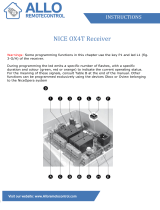 Allo RemoteControl NICE OX4T Operating instructions
Allo RemoteControl NICE OX4T Operating instructions
-
Nice FLOXI2R Owner's manual
-
Nice ROAD 400 Instructions And Warnings For Installation And Use
-
 Mhouse GTX4 Owner's manual
Mhouse GTX4 Owner's manual
-
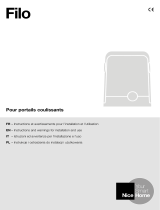 NiceHome FILO 400 / 600 Owner's manual
NiceHome FILO 400 / 600 Owner's manual
-
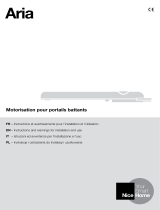 NiceHome ARIA Owner's manual
NiceHome ARIA Owner's manual
-
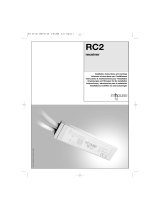 Mhouse RC2 Owner's manual
Mhouse RC2 Owner's manual
-
Telcoma FM 400 SR2 Owner's manual
-
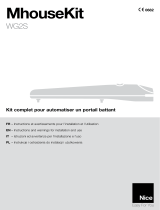 Mhouse MhouseKit WG2S Instructions For Installation And Use Manual
Mhouse MhouseKit WG2S Instructions For Installation And Use Manual















